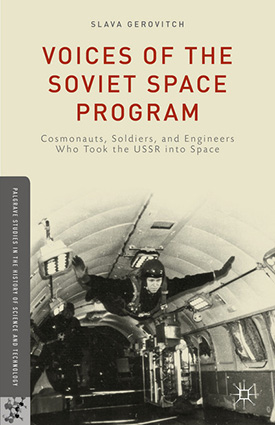Slava Gerovitch, Voices of the Soviet Space Program: Cosmonauts, Soldiers, and Engineers Who Took the USSR into Space (Palgrave Macmillan, 2014)
Slava Gerovitch is a lecturer in history of mathematics at the Massachusetts Institute of Technology. He is the author of From Newspeak to Cyberspeak: A History of Soviet Cybernetics (2002) and Soviet Space Mythologies: Public Images, Private Memories, and the Making of a Cultural Identity (2015).
Endorsement
“For anyone wanting to penetrate the history of the Soviet space program more deeply than just leading figures like Sergei Korolev and Yuri Gagarin, this collection of interviews is invaluable. It shows the development and organization of the Soviet program from a multitude of viewpoints — military personnel from the Soviet missile forces, engineers, flown and backup cosmonauts, and scientists. With its rich cast of characters, each with their own story, this work reads almost like a Russian novel, providing valuable insights into how working on the Soviet space program affected the lives of the many people whose combined work turned Russia into a leading space power.”
—Jeffrey Hoffman, former US astronaut and Professor of the Practice of Aerospace Engineering, Massachusetts Institute of Technology
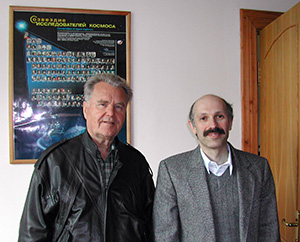
Vladimir Shatalov and Slava Gerovitch at Star City Museum, May 2006 (courtesy Asif Siddiqi).
Reviews
“Voices of the Soviet Space Program unites an invaluable collection of individual experiences and personal viewpoints. ... the interviews ... reveal ample new insights, aspects, and details that cannot be found in official documents and archival resources. ...the accounts in Voices of the Soviet Space Program in particular give rare glimpses into daily life and routine in the celebrated space program.”
—Julia Richers, Kritika: Explorations in Russian and Eurasian History
“Few scholars would be better placed to attempt such a project. Gerovitch does a wonderful job in the introduction explaining the value of oral history as an approach, and distinguishes it theoretically from memory studies. It becomes clear to the reader almost immediately that Gerovitch possesses both advanced knowledge of the scientific and technological disciplines under discussion and a sophisticated, highly nuanced understanding of the Soviet system. The erudition of the interviewer is tremendous, as the footnotes frequently demonstrate. The level of trust that exists between Gerovitch and the interviewees is quite stunning, and the questioning superb. Gerovitch guided the interviews skillfully without interjecting his own critique. He established authority by connecting with his subjects as an insider while simultaneously embracing the critical distance that comes from external expertise.”
—Roshanna Sylvester, Quest: The History of Spaceflight Quarterly
“Slava Gerovitch … has assembled here a vibrant collection of thirteen interviews that he conducted with Russian space personalities in the U.S. and Russia between 2002 and 2010. … This is all a rare and welcome achievement in the literature. … In sum, this excellent book reveals new facts and insights on the personal, institutional, technical, and political facets of Soviet rocketry and spaceflight policies and practices between the Second World War and the end of the Cold War.”
—Michael G. Smith, Slavic Review
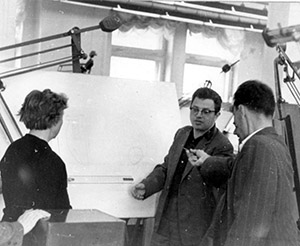
Anatoliy Daron (center) at work in Glushko’s design bureau (courtesy Anatoliy Daron).
“Slava Gerovitch … has published a fascinating primary source in Voices of the Soviet Space Program. This book consists of thirteen interviews with cosmonauts, soldiers, and engineers that Gerovitch … conducted from 2002 to 2010 over several oral history projects. … The interviews enable the reader to learn about the beginnings of the Soviet space program … . This is an important contribution to space history, cold war history, the history of the USSR, and the history of technology.”
—Paul Josephson, Technology & Culture
“Slava Gerovitch has purposely set out to go beyond the familiar territory and record the history of those times through the recollections of engineers from rival design bureaus, cosmonauts and cosmonaut trainees, information technology specialists and military officers responsible for construction and operational running of facilities and government machine works. ... This book is a valuable resource rich in frank recollections of less well known Russian and Soviet personalities, as well as important cosmonauts such as Vladimir Shatalov, who reveals a complex web of contacts across the industrial, scientific, engineering and political hierarchies in this small but seminal work.”
—David Baker, Spaceflight
“These interviews are not part of a comprehensive collection like the Oral History Project of NASA’s Johnson Space Center but were done, like so much in Russia, by access to friends of friends. These informal vertical and horizontal networks played an important role in the success of the Soviet space program.”
—Jonathan Coopersmith, Isis: A Journal of the History of Science Society
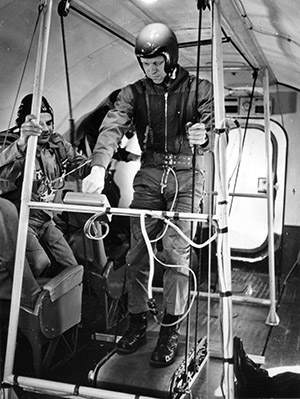
Mikhail Burdayev during zero gravity training, 1972 (courtesy Mikhail Burdayev).
“On the one hand, the interviews provide information in the scientific-military area, where a large part of the archives are still closed to research, so that memories or oral histories in many cases remain the only accessible source. ... On the other hand, they provide a unique insight into the scientific community of the Soviet space program, its everyday practices and group identities, legitimacy narratives and distinctive gestures under the conditions of massive state control and regulation, since a large number of scientists and military personnel involved could never appear in public, while the cosmonauts and official representatives had to abide by extremely standardised and coded language regulations.”
—Matthias Schwartz, Jahrbücher für Geschichte Osteuropas (in German)
“With Voices of the Soviet Space Program, Slava Gerovitch offers an indispensable tool for any researcher interested in the history of Soviet space science and technology in the second half of the 20th century. ...this scholarly initiative, in addition to its factual contributions, should be welcomed for the perspective it opens into the subjectivity of space actors, caught up in contradictory relations with the Soviet regime, mixing doubts and criticisms with forms of adherence to socialist ideals.”
—Isabelle Gouarné, Humanités spatiales (in French)
“The voices of the protagonists, it is true, cancel out much of the official story that emanated from above... These allow us to better evaluate what lay behind the dominant narrative, while completing, correcting, supplementing or denying the vision we possess of the Soviet space program. The task of collecting and evoking these stories was undertaken Slava Gerovitch in Voices of the Soviet Space Program, and for this mission we must undoubtedly recognize the value of this work.”
—Esteban González Rittler, Rey Desnudo (in Spanish)
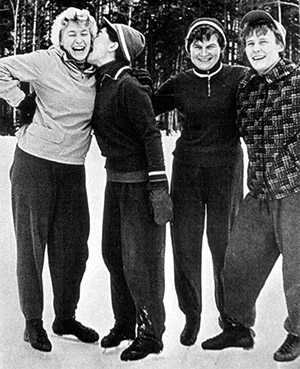
Women cosmonauts (from left): Tatyana Kuznetsova, Irina Solovyeva, Valentina Tereshkova, and Valentina Ponomareva (courtesy Valentina Ponomareva).
Booksellers
Despite the wealth of information and archival material that has become available in the years following the fall of the USSR, the history of the Soviet space program has been dominated by the accounts of a select few, such as the recent four-volume English translation of Russian rocket designer Boris Chertok.
In this remarkable oral history, author and interviewer Slava Gerovitch helps to enrich and complicate space historiography by presenting interviews with the men and women who witnessed Soviet space efforts firsthand, from the cosmonauts themselves to the military officials who directed the program to the engineers who made real the grand ambitions of the USSR.
Rather than comprising a monolithic “master narrative,” these fascinating and varied accounts bring to light the often divergent perspectives, experiences, and institutional cultures that defined the Soviet space program.

From left: Abram Krayzman, Sergey Korolev, Petr Chernenko. Laboratory testing of V-2, Sondershausen, Germany, March 1946 (courtesy Abram Krayzman).
Introduction. Multiple Perspectives on Soviet Space History (PDF)
Part I. The Soldiers
Chapter 1. Commanding Officer Abram Krayzman
Abram Krayzman was among the group of Soviet military officers who played a key role in the transfer of rocket technology and know-how from Germany to the Soviet Union in the wake of World War II, and he took an active part in the formation of the Soviet Missile Forces. His story vividly illustrates the origins of the Soviet space program in postwar missile developments and gives a glimpse of close interactions between the military and the early rocket engineers who would become well-known Soviet designers of space launchers and spacecraft.
Chapter 2. Construction Engineer Sergey Safro
As a military construction officer at Tyuratam (Baykonur), Sergey Safro provides a ground-level perspective on everyday life at the main Soviet spaceport and rocket testing site in the early 1960s. Boredom, harsh life conditions, and all-pervasive secrecy dominated the daily experiences of the military personnel at the launching pad of Soviet space triumphs.
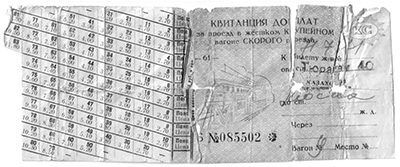
Railroad ticket from Moscow to Tyratam-40, future Baykonur (courtesy Sergey Safro).
Part II. The Engineers
Chapter 3. Engine Designer Anatoliy Daron (Russian original)
Anatoliy Daron, a brilliant engineer and the mind behind the most famous Soviet rocket engine, gives a firsthand account of the transition of Soviet rocketry from the learning and imitation of German technology to new, innovative designs. Daron’s account of numerous challenges of rocket engine design and testing provides a rare insight into the engineering culture of Soviet rocketry. His analysis of the failings of the Soviet N1 lunar rocket’s design is a crucial addition to the history of the Soviet piloted lunar program. Daron, who worked for Chief Designer Valentin Glushko, also discusses the notorious dispute between Glushko and Chief Designer Sergey Korolev from the perspective of the Glushko camp, adding complexity to the conventional accounts told by the Korolev side. Daron also offers some provocative ideas about the future of human spaceflight.
Chapter 4. Guidance Engineer Sergei Khrushchev
Sergei Khrushchev has a unique insight into the inner workings of the Soviet space program. A control systems designer at Vladimir Chelomey’s design bureau, a major competitor of Sergey Korolev’s OKB-1, he also participated in discussions and business travels with his father, the Soviet premier Nikita Khrushchev. While Sergei Khrushchev’s published memoirs focus on high-level deliberations involving his father and the leadership of the Soviet space program, the interview included in this collection reveals the organizational and engineering culture of Chelomey’s firm and its complex relationships with the rest of the Soviet rocket-space industry. Sergei Khrushchev’s account suggests that behind the rivalry over space projects between Chelomey and Korolev was not merely institutional competition for resources but a clash of two engineering cultures, one coming from aviation and the other from rocketry.
Chapter 5. Control Engineer Georgiy Priss
Georgiy Priss, a leading designer of control systems for rocketry, explains the engineering philosophy professed by Chief Designer Nikolay Pilyugin. Pilyugin’s organization developed onboard guidance systems that give rockets “autonomy” from ground control and freed rocketry from the vulnerability of interference-prone radio communications. Pilyugin strove for similar autonomy in his design principles: all components of the control systems were to be designed at his own organization, rather than outsourced to other companies. Priss further discusses the role of onboard computing and its impact on the division of function between human and machine in spacecraft control. The twists and turns in the collaboration between Pilyugin and Chief Designer Sergey Korolev are also presented from the perspective of Pilyugin’s organization.
Chapter 6. Radio Engineer Felix Meschansky
As a leading specialist in space radio communications, Felix Meschansky was involved in the preparation and implementation of a number of lunar probe missions, and in the development of scientific and engineering foundations for deep space communication. This interview explains several incidents of communication failure during space missions, discusses the different personalities and management styles of the chief designers Korolev and Ryazanskiy, and tells a remarkable story of Meschansky putting his personal career on the line by violating an established procedure in order to implement an ingenious engineering solution of a serious problem.
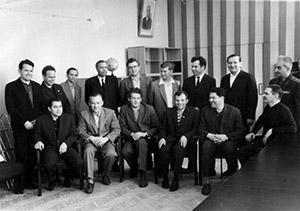
Cosmonauts’ visit to Glushko’s design bureau. In the front row, Valentin Glushko (far right) and the cosmonauts Yuriy Gagarin (third from the right) and Andriyan Nikolayev (far left). In the back row, Anatoliy Daron (center) (courtesy Anatoliy Daron).
Chapter 7. Display Designer Yuriy Tyapchenko
Yuriy Tyapchenko’s long-term career as a designer of information display systems for Soviet piloted spacecraft has placed him at the center of debates over the role of the cosmonaut on board, the division of function between human and machine, and the ways to integrate a cosmonaut into the technological system of spacecraft. In this interview, Tyapchenko discusses factors that shaped the design of control panels and hand controllers, the input of cosmonauts in the design process, and the institutional context of Soviet information display engineering.
Online supplement: Information display systems for piloted Soviet spacecraft
Chapter 8. Computer Designer Viktor Przhiyalkovskiy
Viktor Przhiyalkovskiy led the design of onboard computers for Soviet piloted spacecraft and space stations. He discusses the technical challenges of designing computers for space, the organizational and economic issues in the Soviet computer industry, and the barriers for innovation in the conservative, risk-averse culture of space technology. According to his account, production of computers for the military always took priority over space computing, and this led to the proliferation of different models of onboard computers of varying quality. He also explains the engineering philosophy of onboard computer designers. This philosophy is technology centered: the computer serves as an autonomous decision maker, while the cosmonaut only monitors its operations.
Online supplement: Soviet on-board computers for spacecraft
Part III. The Cosmonauts
Chapter 9. “Cosmonaut 13”: Vladimir Shatalov
Vladimir Shatalov was the first man in space to perform a demanding and risky operation of orbital docking of two piloted spacecraft. After two more challenging flights, he became the top Air Force official in charge of cosmonaut selection and training—the position he occupied for 20 years. His interview provides vivid details of cosmonaut daily life and training, crew selection, and mission operations. His account of the failed docking during his Soyuz 10 mission illustrates the degree of miscommunication and mutual distrust between the engineers and the cosmonauts, in post-flight investigations. Describing his work as assistant chief of the Air Force for spaceflight, Shatalov reveals a complex web of informal relationships among Party officials, chief designers, and the military, which often interfered with formal hierarchies and blurred the division of responsibility. Shatalov also discusses the impact of secrecy requirements on his family life and on international collaboration.
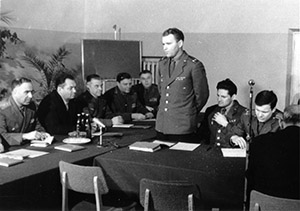
Meeting of the State Commission confirming the crew for the Soyuz 4-5 mission, January 12, 1969. Left to right: commission chairman Lieutenant General Kerim Kerimov, the General Designer Vasiliy Mishin, the Deputy Chief of Air Force, Major General Andrey Karas, the deputy commander of the cosmodrome, Vladimir Shatalov (standing), Boris Volynov, and Evgeny Khrunov (courtesy Vladimir Shatalov).
Chapter 10. Test Cosmonaut Mikhail Burdayev
Despite his thorough cosmonaut training and superb qualifications, Mikhail Burdayev did not get a chance to fly in space. His background as a military researcher set him apart from the military pilots, who comprised the majority in the cosmonaut corps, and gave him a distinct perspective on the organization of cosmonaut selection and training. In this interview, he discusses the grueling process of cosmonaut training, the politics of crew selection, and the relations among different professional groups composing the cosmonaut corps. Burdayev also recalls episodes from his later career as a shift leader of the mission control group, discusses the problem of human spaceflight versus automatic probes, and reflects on his career shift from training as a cosmonaut to being a space scientist.
Chapter 11. Scientist Cosmonaut Ordinard Kolomiytsev
An astrophysicist and polar explorer, Ordinard Kolomiytsev trained to become one of the first Soviet academic scientists in space, but Soviet space officials eventually changed their mind and disbanded the cosmonaut group of the Academy of Sciences. Kolomiytsev offers an account of his polar exploits, cosmonaut training, and the subsequent successful academic career, suggesting that the exclusion of scientists from the cosmonaut corps damaged the Soviet space program by closing an opportunity to integrate cutting-edge research into cosmonaut activities.
Chapter 12. “Second Backup”: Valentina Ponomareva
Valentina Ponomareva trained to fly the first woman’s space mission and later to be the commander of the first all-women group mission, but the shifting priorities of the Soviet space program eventually prevented her from flying into space. She became a historian of cosmonautics, and in this interview she offers both personal recollections of her training and a historical analysis of fundamental flaws in the philosophy of Soviet space engineering and Soviet space policy, involving an excessive emphasis on automation and the subordination of cosmonauts’ initiative to the logic of automatic systems.
Chapter 13. Stress Psychiatrist Ada Ordyanskaya
Ada Ordyanskaya, a psychiatrist specializing in stress-induced pathology, served as a consultant for the Soviet space program on several occasions when Mission Control became seriously concerned about the psychological state of the crew. In this interview, without disclosing sensitive details, she discusses several such cases. Her account lifts the veil of silence over instances of psychological disadaptation during Soviet space missions and provides a glimpse into the suppressed tensions in the military-dominated culture of the Soviet cosmonaut corps.
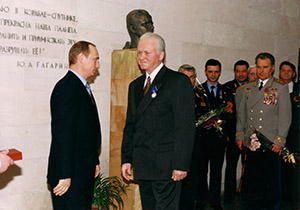
Acting President Vladimir Putin awards the Order of Honor to Mikhail Burdayev (second from left). On the right, cosmonaut Vladimir Shatalov. Star City, March 2, 2000 (courtesy Mikhail Burdayev).
Online supplement: List of Personalities of the Soviet Space Program
Online supplement: Glossary of Institutions of the Soviet Space Program
